Investigating Safety Breaches: The Santiago de Compostela Derailment
VerifiedAdded on 2023/06/05
|8
|2168
|415
Report
AI Summary
This report investigates the safety breaches that led to the derailment of the Santiago de Compostela train. The primary causes identified include human error, specifically the train driver's distraction due to phone calls, and the absence of automated safety engineering systems that could have red...
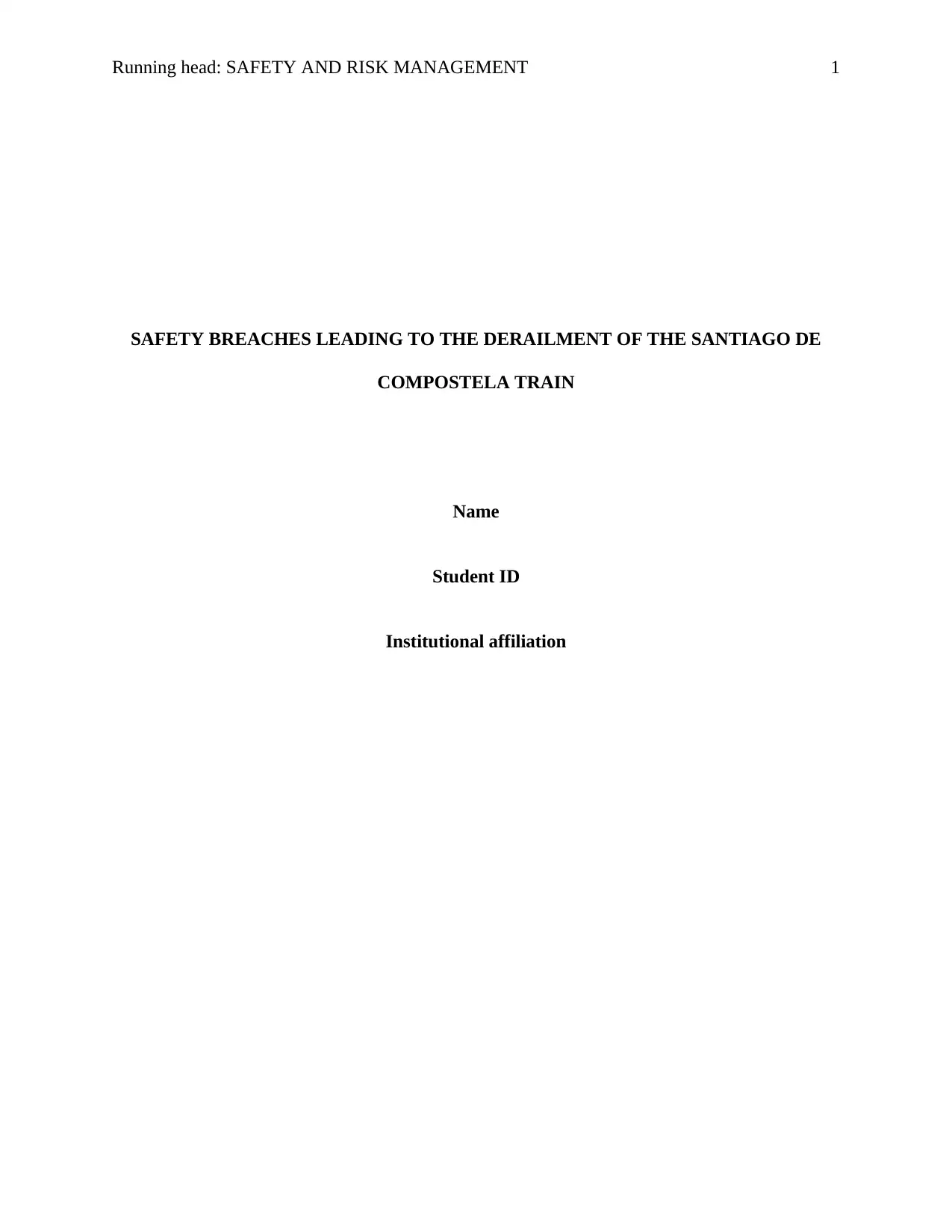
Running head: SAFETY AND RISK MANAGEMENT 1
SAFETY BREACHES LEADING TO THE DERAILMENT OF THE SANTIAGO DE
COMPOSTELA TRAIN
Name
Student ID
Institutional affiliation
SAFETY BREACHES LEADING TO THE DERAILMENT OF THE SANTIAGO DE
COMPOSTELA TRAIN
Name
Student ID
Institutional affiliation
Paraphrase This Document
Need a fresh take? Get an instant paraphrase of this document with our AI Paraphraser
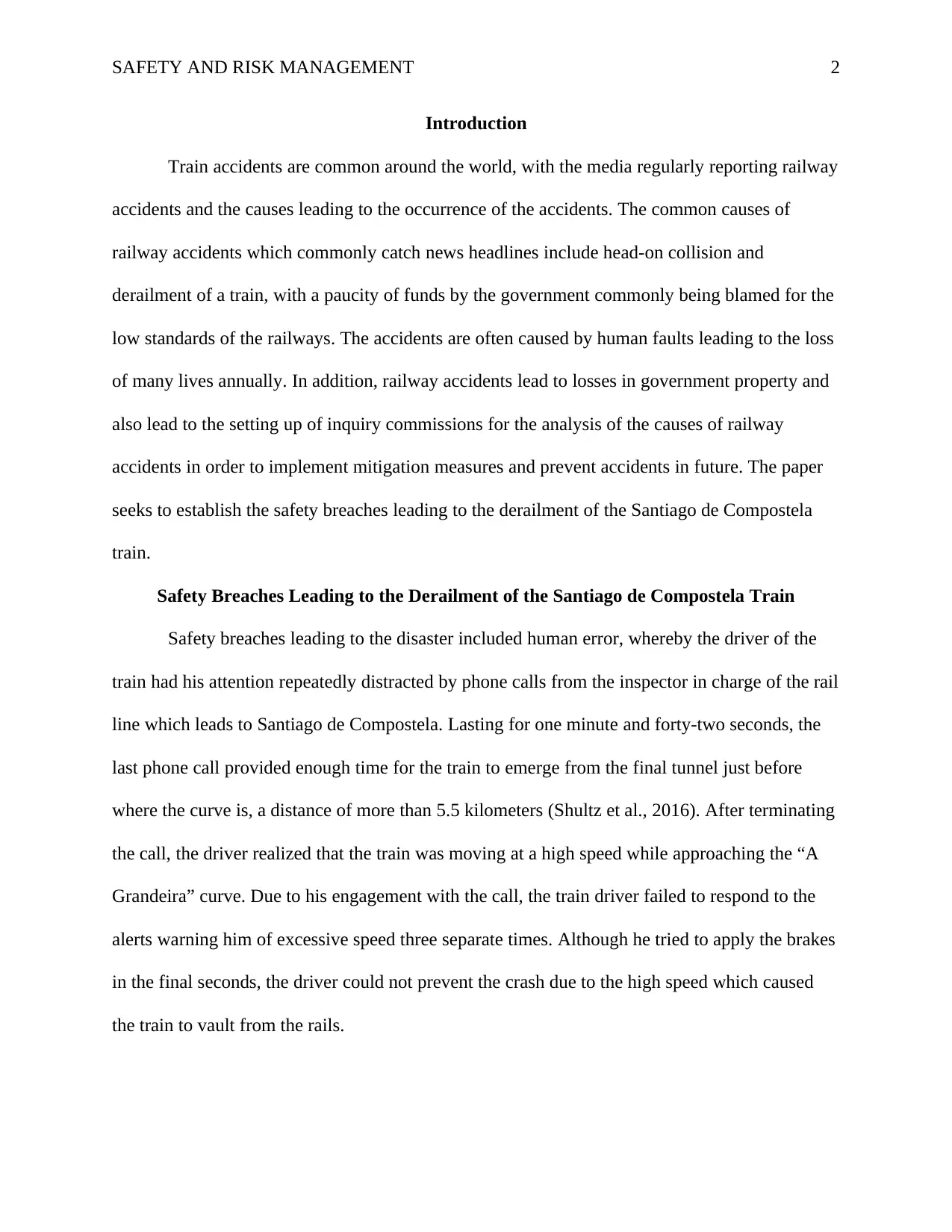
SAFETY AND RISK MANAGEMENT 2
Introduction
Train accidents are common around the world, with the media regularly reporting railway
accidents and the causes leading to the occurrence of the accidents. The common causes of
railway accidents which commonly catch news headlines include head-on collision and
derailment of a train, with a paucity of funds by the government commonly being blamed for the
low standards of the railways. The accidents are often caused by human faults leading to the loss
of many lives annually. In addition, railway accidents lead to losses in government property and
also lead to the setting up of inquiry commissions for the analysis of the causes of railway
accidents in order to implement mitigation measures and prevent accidents in future. The paper
seeks to establish the safety breaches leading to the derailment of the Santiago de Compostela
train.
Safety Breaches Leading to the Derailment of the Santiago de Compostela Train
Safety breaches leading to the disaster included human error, whereby the driver of the
train had his attention repeatedly distracted by phone calls from the inspector in charge of the rail
line which leads to Santiago de Compostela. Lasting for one minute and forty-two seconds, the
last phone call provided enough time for the train to emerge from the final tunnel just before
where the curve is, a distance of more than 5.5 kilometers (Shultz et al., 2016). After terminating
the call, the driver realized that the train was moving at a high speed while approaching the “A
Grandeira” curve. Due to his engagement with the call, the train driver failed to respond to the
alerts warning him of excessive speed three separate times. Although he tried to apply the brakes
in the final seconds, the driver could not prevent the crash due to the high speed which caused
the train to vault from the rails.
Introduction
Train accidents are common around the world, with the media regularly reporting railway
accidents and the causes leading to the occurrence of the accidents. The common causes of
railway accidents which commonly catch news headlines include head-on collision and
derailment of a train, with a paucity of funds by the government commonly being blamed for the
low standards of the railways. The accidents are often caused by human faults leading to the loss
of many lives annually. In addition, railway accidents lead to losses in government property and
also lead to the setting up of inquiry commissions for the analysis of the causes of railway
accidents in order to implement mitigation measures and prevent accidents in future. The paper
seeks to establish the safety breaches leading to the derailment of the Santiago de Compostela
train.
Safety Breaches Leading to the Derailment of the Santiago de Compostela Train
Safety breaches leading to the disaster included human error, whereby the driver of the
train had his attention repeatedly distracted by phone calls from the inspector in charge of the rail
line which leads to Santiago de Compostela. Lasting for one minute and forty-two seconds, the
last phone call provided enough time for the train to emerge from the final tunnel just before
where the curve is, a distance of more than 5.5 kilometers (Shultz et al., 2016). After terminating
the call, the driver realized that the train was moving at a high speed while approaching the “A
Grandeira” curve. Due to his engagement with the call, the train driver failed to respond to the
alerts warning him of excessive speed three separate times. Although he tried to apply the brakes
in the final seconds, the driver could not prevent the crash due to the high speed which caused
the train to vault from the rails.
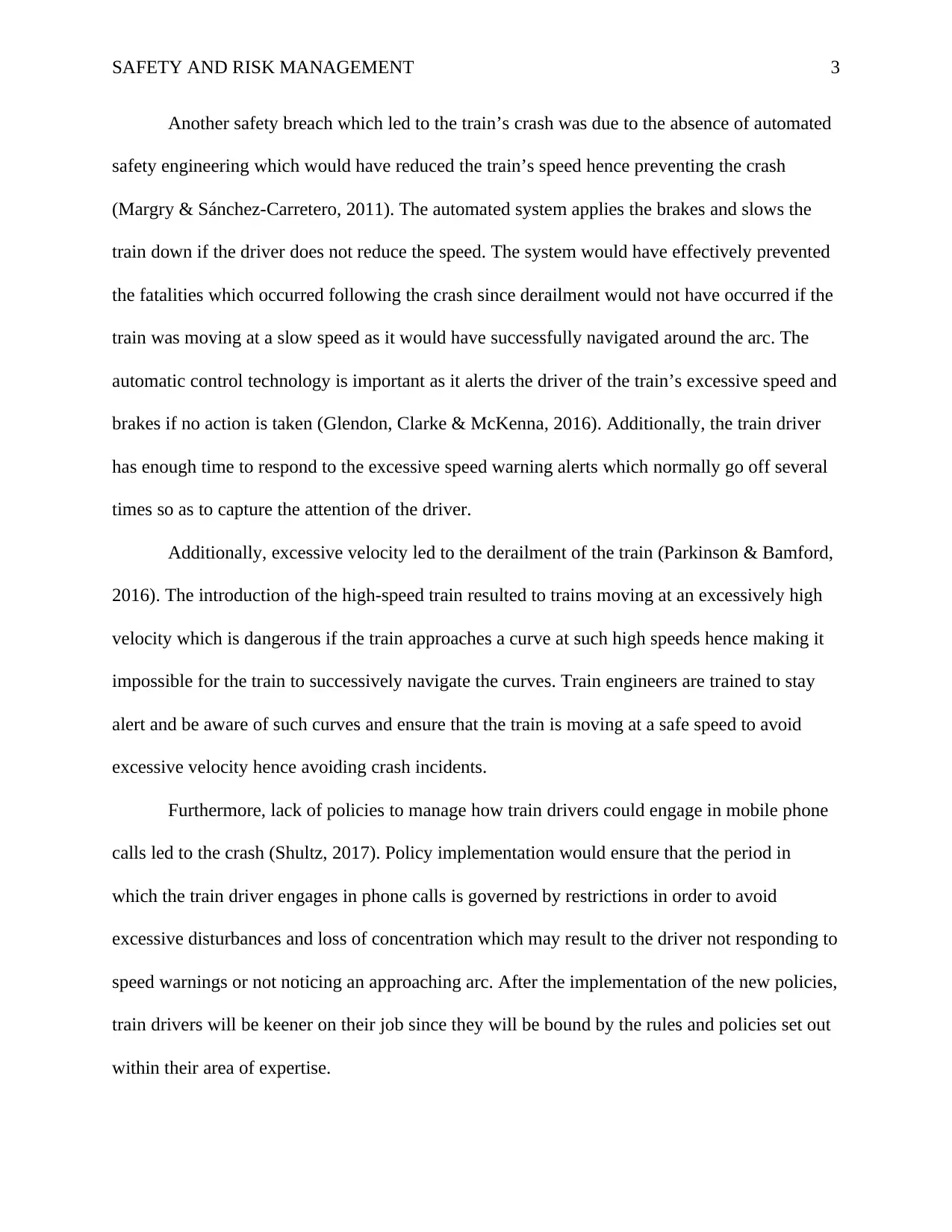
SAFETY AND RISK MANAGEMENT 3
Another safety breach which led to the train’s crash was due to the absence of automated
safety engineering which would have reduced the train’s speed hence preventing the crash
(Margry & Sánchez-Carretero, 2011). The automated system applies the brakes and slows the
train down if the driver does not reduce the speed. The system would have effectively prevented
the fatalities which occurred following the crash since derailment would not have occurred if the
train was moving at a slow speed as it would have successfully navigated around the arc. The
automatic control technology is important as it alerts the driver of the train’s excessive speed and
brakes if no action is taken (Glendon, Clarke & McKenna, 2016). Additionally, the train driver
has enough time to respond to the excessive speed warning alerts which normally go off several
times so as to capture the attention of the driver.
Additionally, excessive velocity led to the derailment of the train (Parkinson & Bamford,
2016). The introduction of the high-speed train resulted to trains moving at an excessively high
velocity which is dangerous if the train approaches a curve at such high speeds hence making it
impossible for the train to successively navigate the curves. Train engineers are trained to stay
alert and be aware of such curves and ensure that the train is moving at a safe speed to avoid
excessive velocity hence avoiding crash incidents.
Furthermore, lack of policies to manage how train drivers could engage in mobile phone
calls led to the crash (Shultz, 2017). Policy implementation would ensure that the period in
which the train driver engages in phone calls is governed by restrictions in order to avoid
excessive disturbances and loss of concentration which may result to the driver not responding to
speed warnings or not noticing an approaching arc. After the implementation of the new policies,
train drivers will be keener on their job since they will be bound by the rules and policies set out
within their area of expertise.
Another safety breach which led to the train’s crash was due to the absence of automated
safety engineering which would have reduced the train’s speed hence preventing the crash
(Margry & Sánchez-Carretero, 2011). The automated system applies the brakes and slows the
train down if the driver does not reduce the speed. The system would have effectively prevented
the fatalities which occurred following the crash since derailment would not have occurred if the
train was moving at a slow speed as it would have successfully navigated around the arc. The
automatic control technology is important as it alerts the driver of the train’s excessive speed and
brakes if no action is taken (Glendon, Clarke & McKenna, 2016). Additionally, the train driver
has enough time to respond to the excessive speed warning alerts which normally go off several
times so as to capture the attention of the driver.
Additionally, excessive velocity led to the derailment of the train (Parkinson & Bamford,
2016). The introduction of the high-speed train resulted to trains moving at an excessively high
velocity which is dangerous if the train approaches a curve at such high speeds hence making it
impossible for the train to successively navigate the curves. Train engineers are trained to stay
alert and be aware of such curves and ensure that the train is moving at a safe speed to avoid
excessive velocity hence avoiding crash incidents.
Furthermore, lack of policies to manage how train drivers could engage in mobile phone
calls led to the crash (Shultz, 2017). Policy implementation would ensure that the period in
which the train driver engages in phone calls is governed by restrictions in order to avoid
excessive disturbances and loss of concentration which may result to the driver not responding to
speed warnings or not noticing an approaching arc. After the implementation of the new policies,
train drivers will be keener on their job since they will be bound by the rules and policies set out
within their area of expertise.
You're viewing a preview
Unlock full access by subscribing today!
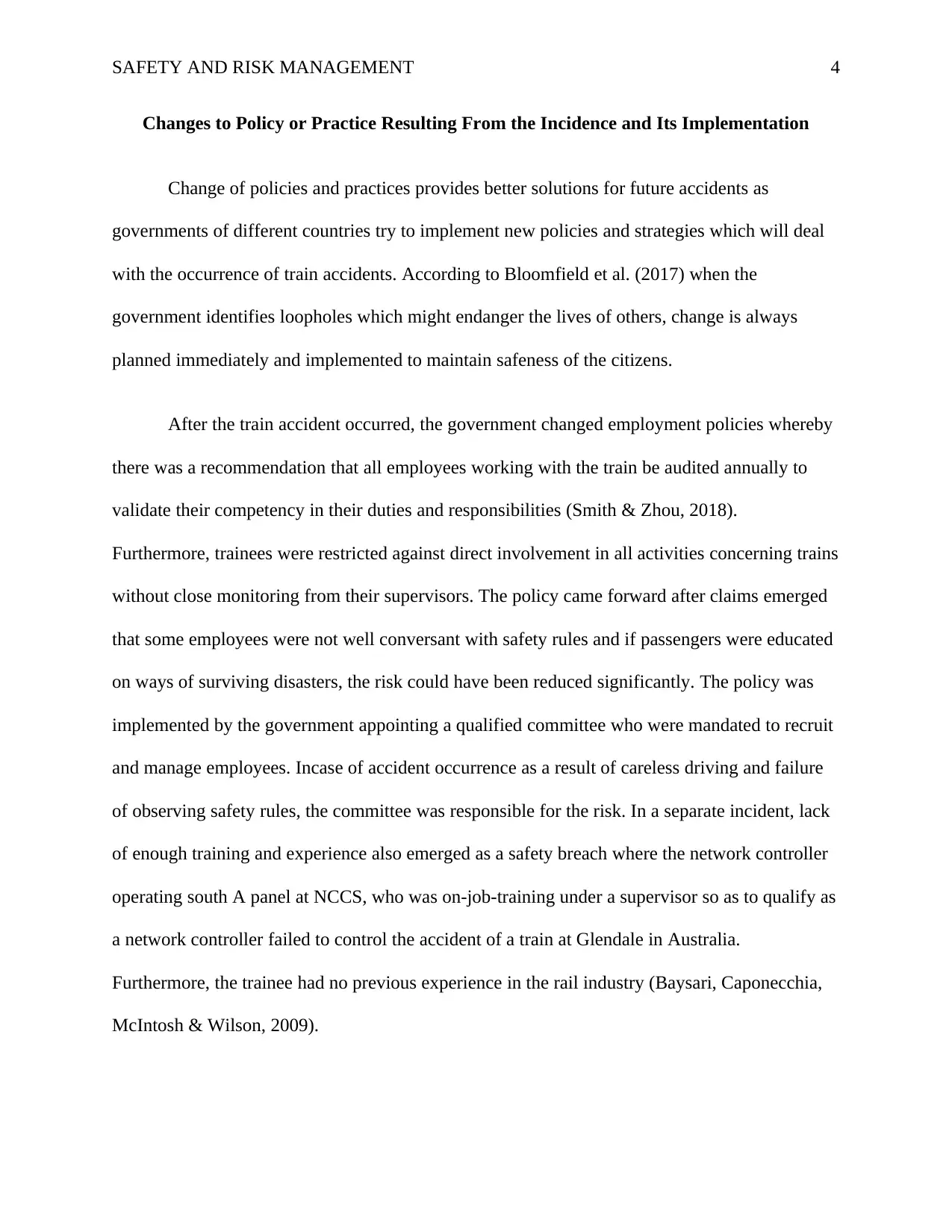
SAFETY AND RISK MANAGEMENT 4
Changes to Policy or Practice Resulting From the Incidence and Its Implementation
Change of policies and practices provides better solutions for future accidents as
governments of different countries try to implement new policies and strategies which will deal
with the occurrence of train accidents. According to Bloomfield et al. (2017) when the
government identifies loopholes which might endanger the lives of others, change is always
planned immediately and implemented to maintain safeness of the citizens.
After the train accident occurred, the government changed employment policies whereby
there was a recommendation that all employees working with the train be audited annually to
validate their competency in their duties and responsibilities (Smith & Zhou, 2018).
Furthermore, trainees were restricted against direct involvement in all activities concerning trains
without close monitoring from their supervisors. The policy came forward after claims emerged
that some employees were not well conversant with safety rules and if passengers were educated
on ways of surviving disasters, the risk could have been reduced significantly. The policy was
implemented by the government appointing a qualified committee who were mandated to recruit
and manage employees. Incase of accident occurrence as a result of careless driving and failure
of observing safety rules, the committee was responsible for the risk. In a separate incident, lack
of enough training and experience also emerged as a safety breach where the network controller
operating south A panel at NCCS, who was on-job-training under a supervisor so as to qualify as
a network controller failed to control the accident of a train at Glendale in Australia.
Furthermore, the trainee had no previous experience in the rail industry (Baysari, Caponecchia,
McIntosh & Wilson, 2009).
Changes to Policy or Practice Resulting From the Incidence and Its Implementation
Change of policies and practices provides better solutions for future accidents as
governments of different countries try to implement new policies and strategies which will deal
with the occurrence of train accidents. According to Bloomfield et al. (2017) when the
government identifies loopholes which might endanger the lives of others, change is always
planned immediately and implemented to maintain safeness of the citizens.
After the train accident occurred, the government changed employment policies whereby
there was a recommendation that all employees working with the train be audited annually to
validate their competency in their duties and responsibilities (Smith & Zhou, 2018).
Furthermore, trainees were restricted against direct involvement in all activities concerning trains
without close monitoring from their supervisors. The policy came forward after claims emerged
that some employees were not well conversant with safety rules and if passengers were educated
on ways of surviving disasters, the risk could have been reduced significantly. The policy was
implemented by the government appointing a qualified committee who were mandated to recruit
and manage employees. Incase of accident occurrence as a result of careless driving and failure
of observing safety rules, the committee was responsible for the risk. In a separate incident, lack
of enough training and experience also emerged as a safety breach where the network controller
operating south A panel at NCCS, who was on-job-training under a supervisor so as to qualify as
a network controller failed to control the accident of a train at Glendale in Australia.
Furthermore, the trainee had no previous experience in the rail industry (Baysari, Caponecchia,
McIntosh & Wilson, 2009).
Paraphrase This Document
Need a fresh take? Get an instant paraphrase of this document with our AI Paraphraser
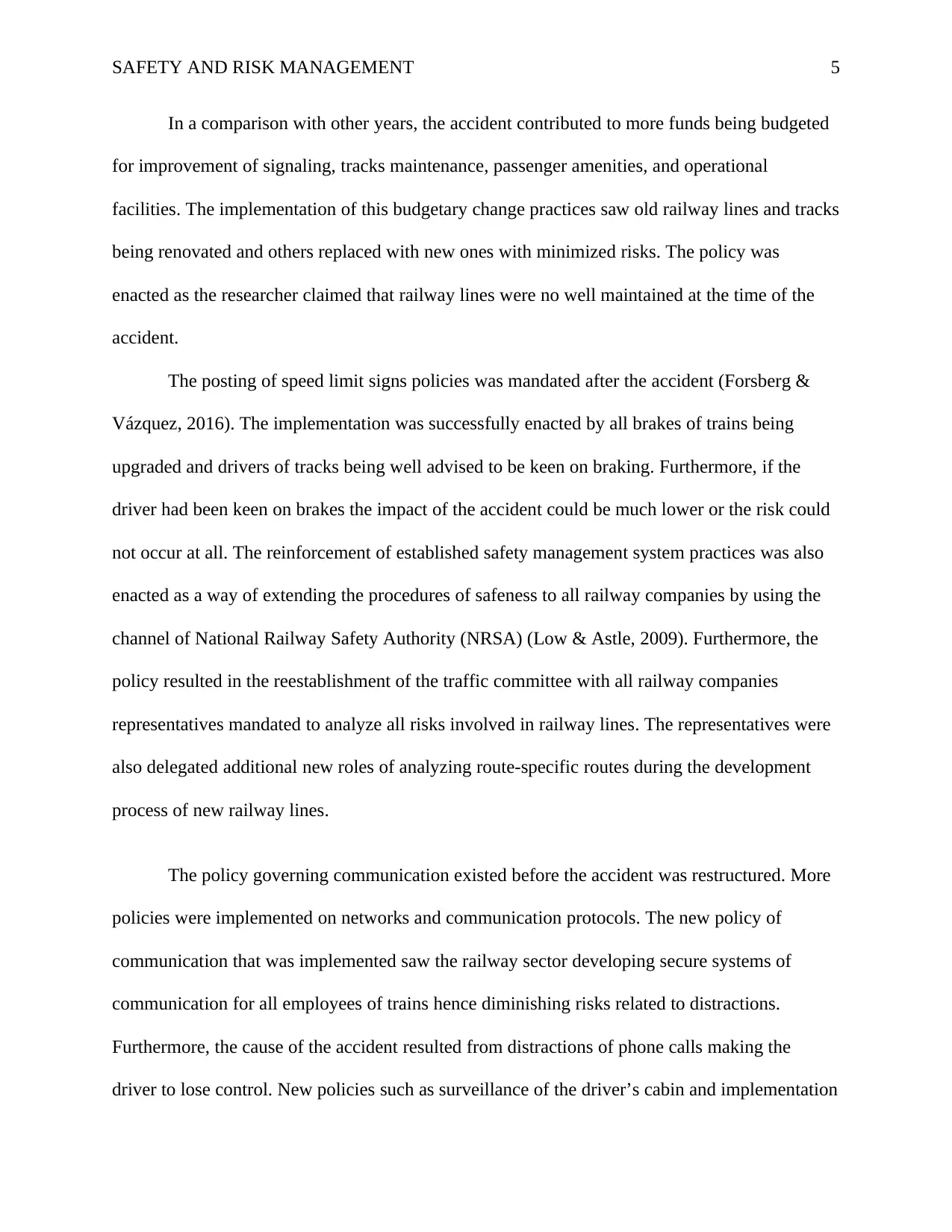
SAFETY AND RISK MANAGEMENT 5
In a comparison with other years, the accident contributed to more funds being budgeted
for improvement of signaling, tracks maintenance, passenger amenities, and operational
facilities. The implementation of this budgetary change practices saw old railway lines and tracks
being renovated and others replaced with new ones with minimized risks. The policy was
enacted as the researcher claimed that railway lines were no well maintained at the time of the
accident.
The posting of speed limit signs policies was mandated after the accident (Forsberg &
Vázquez, 2016). The implementation was successfully enacted by all brakes of trains being
upgraded and drivers of tracks being well advised to be keen on braking. Furthermore, if the
driver had been keen on brakes the impact of the accident could be much lower or the risk could
not occur at all. The reinforcement of established safety management system practices was also
enacted as a way of extending the procedures of safeness to all railway companies by using the
channel of National Railway Safety Authority (NRSA) (Low & Astle, 2009). Furthermore, the
policy resulted in the reestablishment of the traffic committee with all railway companies
representatives mandated to analyze all risks involved in railway lines. The representatives were
also delegated additional new roles of analyzing route-specific routes during the development
process of new railway lines.
The policy governing communication existed before the accident was restructured. More
policies were implemented on networks and communication protocols. The new policy of
communication that was implemented saw the railway sector developing secure systems of
communication for all employees of trains hence diminishing risks related to distractions.
Furthermore, the cause of the accident resulted from distractions of phone calls making the
driver to lose control. New policies such as surveillance of the driver’s cabin and implementation
In a comparison with other years, the accident contributed to more funds being budgeted
for improvement of signaling, tracks maintenance, passenger amenities, and operational
facilities. The implementation of this budgetary change practices saw old railway lines and tracks
being renovated and others replaced with new ones with minimized risks. The policy was
enacted as the researcher claimed that railway lines were no well maintained at the time of the
accident.
The posting of speed limit signs policies was mandated after the accident (Forsberg &
Vázquez, 2016). The implementation was successfully enacted by all brakes of trains being
upgraded and drivers of tracks being well advised to be keen on braking. Furthermore, if the
driver had been keen on brakes the impact of the accident could be much lower or the risk could
not occur at all. The reinforcement of established safety management system practices was also
enacted as a way of extending the procedures of safeness to all railway companies by using the
channel of National Railway Safety Authority (NRSA) (Low & Astle, 2009). Furthermore, the
policy resulted in the reestablishment of the traffic committee with all railway companies
representatives mandated to analyze all risks involved in railway lines. The representatives were
also delegated additional new roles of analyzing route-specific routes during the development
process of new railway lines.
The policy governing communication existed before the accident was restructured. More
policies were implemented on networks and communication protocols. The new policy of
communication that was implemented saw the railway sector developing secure systems of
communication for all employees of trains hence diminishing risks related to distractions.
Furthermore, the cause of the accident resulted from distractions of phone calls making the
driver to lose control. New policies such as surveillance of the driver’s cabin and implementation
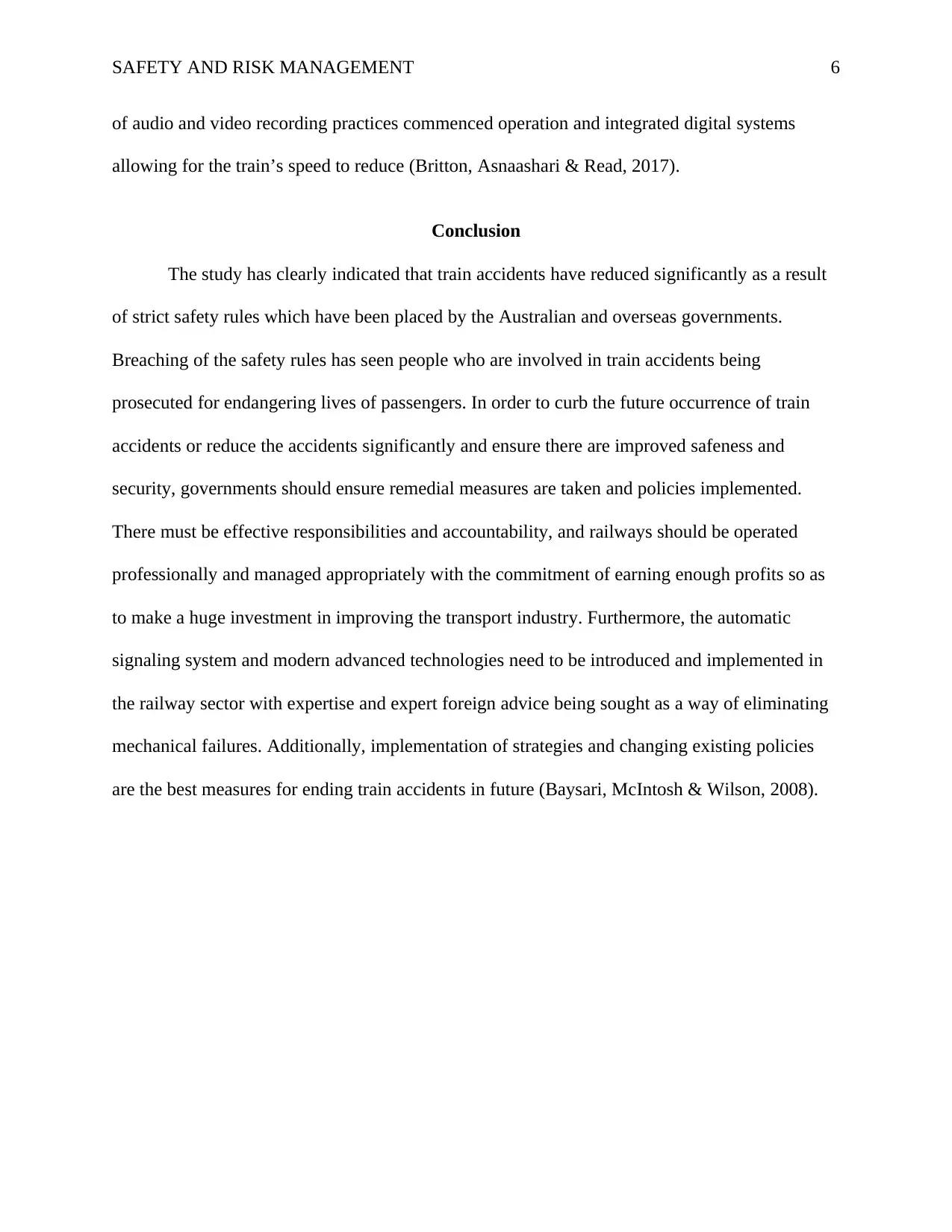
SAFETY AND RISK MANAGEMENT 6
of audio and video recording practices commenced operation and integrated digital systems
allowing for the train’s speed to reduce (Britton, Asnaashari & Read, 2017).
Conclusion
The study has clearly indicated that train accidents have reduced significantly as a result
of strict safety rules which have been placed by the Australian and overseas governments.
Breaching of the safety rules has seen people who are involved in train accidents being
prosecuted for endangering lives of passengers. In order to curb the future occurrence of train
accidents or reduce the accidents significantly and ensure there are improved safeness and
security, governments should ensure remedial measures are taken and policies implemented.
There must be effective responsibilities and accountability, and railways should be operated
professionally and managed appropriately with the commitment of earning enough profits so as
to make a huge investment in improving the transport industry. Furthermore, the automatic
signaling system and modern advanced technologies need to be introduced and implemented in
the railway sector with expertise and expert foreign advice being sought as a way of eliminating
mechanical failures. Additionally, implementation of strategies and changing existing policies
are the best measures for ending train accidents in future (Baysari, McIntosh & Wilson, 2008).
of audio and video recording practices commenced operation and integrated digital systems
allowing for the train’s speed to reduce (Britton, Asnaashari & Read, 2017).
Conclusion
The study has clearly indicated that train accidents have reduced significantly as a result
of strict safety rules which have been placed by the Australian and overseas governments.
Breaching of the safety rules has seen people who are involved in train accidents being
prosecuted for endangering lives of passengers. In order to curb the future occurrence of train
accidents or reduce the accidents significantly and ensure there are improved safeness and
security, governments should ensure remedial measures are taken and policies implemented.
There must be effective responsibilities and accountability, and railways should be operated
professionally and managed appropriately with the commitment of earning enough profits so as
to make a huge investment in improving the transport industry. Furthermore, the automatic
signaling system and modern advanced technologies need to be introduced and implemented in
the railway sector with expertise and expert foreign advice being sought as a way of eliminating
mechanical failures. Additionally, implementation of strategies and changing existing policies
are the best measures for ending train accidents in future (Baysari, McIntosh & Wilson, 2008).
You're viewing a preview
Unlock full access by subscribing today!

SAFETY AND RISK MANAGEMENT 7
References
Baysari, M. T., Caponecchia, C., McIntosh, A. S., & Wilson, J. R. (2009). Classification of
errors contributing to rail incidents and accidents: A comparison of two human error
identification techniques. Safety Science, 47(7), 948-957.
Baysari, M. T., McIntosh, A. S., & Wilson, J. R. (2008). Understanding the human factors
contribution to railway accidents and incidents in Australia. Accident Analysis &
Prevention, 40(5), 1750-1757.
Bloomfield, R., Bendele, M., Bishop, P., Stroud, R., & Tonks, S. (2016, June). The risk
assessment of ERTMS-based railway systems from a cyber security perspective:
Methodology and lessons learned. In International Conference on Reliability, Safety and
Security of Railway Systems (pp. 3-19). Springer, Cham.
Britton, M. A., Asnaashari, S., & Read, G. J. (2017). Analysis of train derailment cause and
outcome in Victoria, Australia, between 2007 and 2013: Implications for regulation.
Journal of Transportation Safety & Security, 9(1), 45-63.
Forsberg, R., & Vázquez, J. A. I. (2016). A case study of the high-speed train crash outside
Santiago de Compostela, Galicia, Spain. Prehospital and disaster medicine, 31(2), 163-
168.
Glendon, A. I., Clarke, S., & McKenna, E. (2016). Human safety and risk management. Crc
Press.
Low, N., & Astle, R. (2009). Path dependence in urban transport: an institutional analysis of
urban passenger transport in Melbourne, Australia, 1956–2006. Transport Policy, 16(2),
47-58.
References
Baysari, M. T., Caponecchia, C., McIntosh, A. S., & Wilson, J. R. (2009). Classification of
errors contributing to rail incidents and accidents: A comparison of two human error
identification techniques. Safety Science, 47(7), 948-957.
Baysari, M. T., McIntosh, A. S., & Wilson, J. R. (2008). Understanding the human factors
contribution to railway accidents and incidents in Australia. Accident Analysis &
Prevention, 40(5), 1750-1757.
Bloomfield, R., Bendele, M., Bishop, P., Stroud, R., & Tonks, S. (2016, June). The risk
assessment of ERTMS-based railway systems from a cyber security perspective:
Methodology and lessons learned. In International Conference on Reliability, Safety and
Security of Railway Systems (pp. 3-19). Springer, Cham.
Britton, M. A., Asnaashari, S., & Read, G. J. (2017). Analysis of train derailment cause and
outcome in Victoria, Australia, between 2007 and 2013: Implications for regulation.
Journal of Transportation Safety & Security, 9(1), 45-63.
Forsberg, R., & Vázquez, J. A. I. (2016). A case study of the high-speed train crash outside
Santiago de Compostela, Galicia, Spain. Prehospital and disaster medicine, 31(2), 163-
168.
Glendon, A. I., Clarke, S., & McKenna, E. (2016). Human safety and risk management. Crc
Press.
Low, N., & Astle, R. (2009). Path dependence in urban transport: an institutional analysis of
urban passenger transport in Melbourne, Australia, 1956–2006. Transport Policy, 16(2),
47-58.
Paraphrase This Document
Need a fresh take? Get an instant paraphrase of this document with our AI Paraphraser
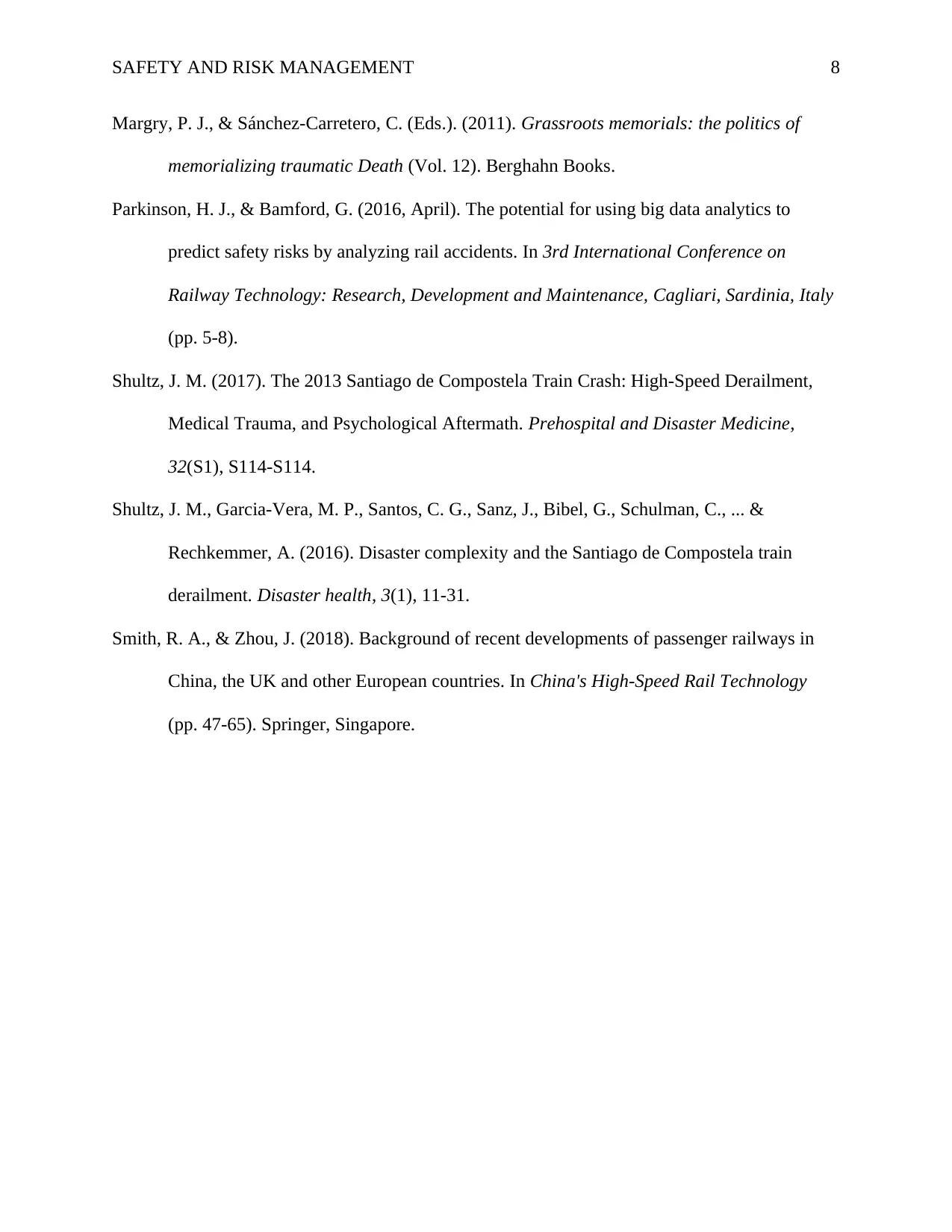
SAFETY AND RISK MANAGEMENT 8
Margry, P. J., & Sánchez-Carretero, C. (Eds.). (2011). Grassroots memorials: the politics of
memorializing traumatic Death (Vol. 12). Berghahn Books.
Parkinson, H. J., & Bamford, G. (2016, April). The potential for using big data analytics to
predict safety risks by analyzing rail accidents. In 3rd International Conference on
Railway Technology: Research, Development and Maintenance, Cagliari, Sardinia, Italy
(pp. 5-8).
Shultz, J. M. (2017). The 2013 Santiago de Compostela Train Crash: High-Speed Derailment,
Medical Trauma, and Psychological Aftermath. Prehospital and Disaster Medicine,
32(S1), S114-S114.
Shultz, J. M., Garcia-Vera, M. P., Santos, C. G., Sanz, J., Bibel, G., Schulman, C., ... &
Rechkemmer, A. (2016). Disaster complexity and the Santiago de Compostela train
derailment. Disaster health, 3(1), 11-31.
Smith, R. A., & Zhou, J. (2018). Background of recent developments of passenger railways in
China, the UK and other European countries. In China's High-Speed Rail Technology
(pp. 47-65). Springer, Singapore.
Margry, P. J., & Sánchez-Carretero, C. (Eds.). (2011). Grassroots memorials: the politics of
memorializing traumatic Death (Vol. 12). Berghahn Books.
Parkinson, H. J., & Bamford, G. (2016, April). The potential for using big data analytics to
predict safety risks by analyzing rail accidents. In 3rd International Conference on
Railway Technology: Research, Development and Maintenance, Cagliari, Sardinia, Italy
(pp. 5-8).
Shultz, J. M. (2017). The 2013 Santiago de Compostela Train Crash: High-Speed Derailment,
Medical Trauma, and Psychological Aftermath. Prehospital and Disaster Medicine,
32(S1), S114-S114.
Shultz, J. M., Garcia-Vera, M. P., Santos, C. G., Sanz, J., Bibel, G., Schulman, C., ... &
Rechkemmer, A. (2016). Disaster complexity and the Santiago de Compostela train
derailment. Disaster health, 3(1), 11-31.
Smith, R. A., & Zhou, J. (2018). Background of recent developments of passenger railways in
China, the UK and other European countries. In China's High-Speed Rail Technology
(pp. 47-65). Springer, Singapore.
1 out of 8
Related Documents
Your All-in-One AI-Powered Toolkit for Academic Success.
+13062052269
info@desklib.com
Available 24*7 on WhatsApp / Email
![[object Object]](/_next/static/media/star-bottom.7253800d.svg)
Unlock your academic potential
© 2024 | Zucol Services PVT LTD | All rights reserved.





